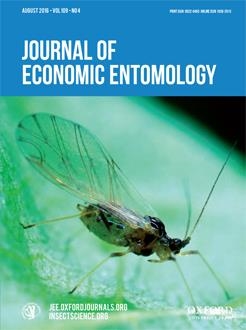Blended refuge for transgenic plants expressing Bacillus thuringiensis (Bt) toxins has been approved in the northern United States as a resistance management strategy alternative to a structured refuge. A three-year study (2012–2014) was conducted with 54 trials across nine states in the southern United States to evaluate plant injury from lepidopteran pests of corn and yield in a corn hybrid expressing Cry1F × Cry1Ab × Vip3Aa20 (Pioneer Brand Optimum Leptra) planted as a pure stand and in refuge blends of 5, 10, and 20% in both early and late plantings. Injury by corn earworm, Helicoverpa zea Boddie (Lepidoptera: Noctuidae), and fall armyworm, Spodoptera frugiperda (J. E. Smith) (Lepidoptera: Noctuidae), was generally proportional to the percentage of non-Bt corn within each refuge blend. Across locations, ear injury in plots with 100% Cry1F × Cry1Ab × Vip3Aa20 (Optimum Leptra) corn ranged from no injury to a maximum of 0.42 cm2 per ear in Mississippi in 2013. Leaf injury ratings in 100% non-Bt plots in early and late planted trials in 2014 were 86- and 70-fold greater than in 100% Cry1F × Cry1Ab × Vip3Aa20 (Optimum Leptra) plots. Plants in plots with blended refuges had significantly greater leaf injury in 2012 (5, 10, and 20% refuge blends), in the early-planted corn in 2013 (10 and 20% only), and in both early- and late-planted corn in 2014 (20% only) as compared with leaf injury in a pure stand of Cry1F × Cry1Ab × Vip3Aa20 (Optimum Leptra) seen during these years. Corn ears in plots with blended refuges also had significantly greater area of kernels injured in 2012 (5, 10, and 20%), in early- and late-planted corn in 2013 (5, 10, and 20%), and in early (10 and 20% only)- and late-planted corn (5, 10, and 20%) in 2014 as compared with ear injury in a pure stand of Cry1F × Cry1Ab × Vip3Aa20 (Optimum Leptra) seen during these years. Infestations of southwestern corn borer, Diatraea grandiosella Dyar (Lepidoptera: Crambidae), were also significantly reduced by Cry1F × Cry1Ab × Vip3Aa20 (Optimum Leptra). Despite these differences in injury, yield averaged across locations varied among refuge blends only in the late-planted trials in 2013, with greater yields in the 0% refuge blend than in the 20% blend; however, when examining yield separately by location, only two of nine locations had higher yields in the 100% Bt plots than in any of the blended refuge plots. As a complement to studying the contribution of blended refuge to delaying resistance, quantifying injury and yield in a range of refuge blends is a necessary step to provide management information on the range of lepidopteran pests that occur in the southern United States.
How to translate text using browser tools
21 June 2016
Impact of Lepidoptera (Crambidae, Noctuidae, and Pyralidae) Pests on Corn Containing Pyramided Bt Traits and a Blended Refuge in the Southern United States
F. P. F. Reay-Jones,
R. T. Bessin,
M. J. Brewer,
D. G. Buntin,
A. L. Catchot,
D. R. Cook,
K. L. Flanders,
D. L. Kerns,
R. P. Porter,
D. D. Reisig,
S. D. Stewart,
M. E. Rice
ACCESS THE FULL ARTICLE
It is not available for individual sale.
This article is only available to subscribers.
It is not available for individual sale.
It is not available for individual sale.

Journal of Economic Entomology
Vol. 109 • No. 4
August 2016
Vol. 109 • No. 4
August 2016
Bacillus thuringiensis
Helicoverpa zea
maize
Optimum Leptra
Spodoptera frugiperda




